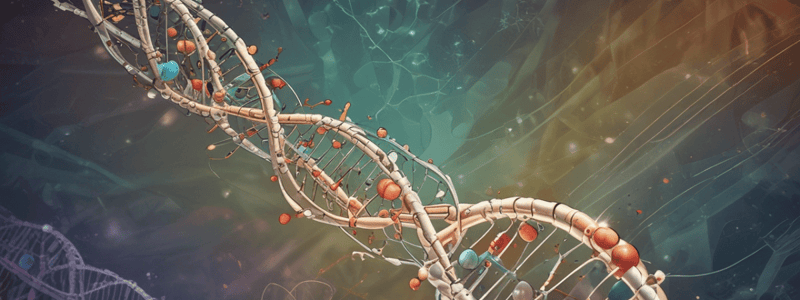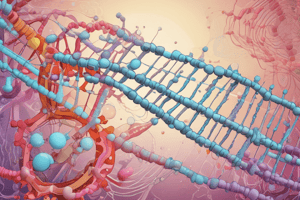Podcast
Questions and Answers
Who discovered the Polymerase Chain Reaction (PCR) in 1983?
Who discovered the Polymerase Chain Reaction (PCR) in 1983?
- Francis Crick
- James Watson
- Kary Mullis (correct)
- Rosalind Franklin
What is the primary purpose of PCR?
What is the primary purpose of PCR?
- To synthesize proteins
- To amplify DNA templates (correct)
- To sequence DNA
- To mutate DNA
What is the maximum length of DNA segments that can be amplified using PCR?
What is the maximum length of DNA segments that can be amplified using PCR?
- 100 bp
- 5000 bp
- 1000 bp (correct)
- 10000 bp
What is the function of primers in PCR?
What is the function of primers in PCR?
What is the temperature used in the denaturation step of PCR?
What is the temperature used in the denaturation step of PCR?
How many steps are involved in a PCR cycle?
How many steps are involved in a PCR cycle?
What is the purpose of the elongation step in PCR?
What is the purpose of the elongation step in PCR?
How many cycles are typically performed in a PCR reaction?
How many cycles are typically performed in a PCR reaction?
What is the basis of separation of macromolecules in gel electrophoresis?
What is the basis of separation of macromolecules in gel electrophoresis?
Why do DNA molecules move towards the positively charged electrode in an electric field?
Why do DNA molecules move towards the positively charged electrode in an electric field?
What happens to smaller DNA fragments during gel electrophoresis?
What happens to smaller DNA fragments during gel electrophoresis?
How are DNA fragments visualized after gel electrophoresis?
How are DNA fragments visualized after gel electrophoresis?
What is the purpose of the power supply in gel electrophoresis?
What is the purpose of the power supply in gel electrophoresis?
What is the direction of movement of DNA fragments during gel electrophoresis?
What is the direction of movement of DNA fragments during gel electrophoresis?
What is the function of the buffer solution in gel electrophoresis?
What is the function of the buffer solution in gel electrophoresis?
What determines the migration rate of DNA fragments during gel electrophoresis?
What determines the migration rate of DNA fragments during gel electrophoresis?
What is the first step in cloning DNA?
What is the first step in cloning DNA?
What is the purpose of using a restriction enzyme?
What is the purpose of using a restriction enzyme?
What happens when the DNA fragments and cut plasmids are mixed?
What happens when the DNA fragments and cut plasmids are mixed?
What is the result of each bacterial cell division?
What is the result of each bacterial cell division?
What is the purpose of selecting cells that contain chimeric plasmids?
What is the purpose of selecting cells that contain chimeric plasmids?
What is the final product of gene cloning?
What is the final product of gene cloning?
What is the role of DNA ligase in gene cloning?
What is the role of DNA ligase in gene cloning?
What is the purpose of growing cells under certain conditions?
What is the purpose of growing cells under certain conditions?
What is the purpose of using restriction enzymes in DNA analysis?
What is the purpose of using restriction enzymes in DNA analysis?
What is the function of the buffer in the Southern blotting process?
What is the function of the buffer in the Southern blotting process?
What is the purpose of X-ray film in autoradiography?
What is the purpose of X-ray film in autoradiography?
What is the purpose of the labeled probe in Southern blotting?
What is the purpose of the labeled probe in Southern blotting?
What is the result of the gel electrophoresis process?
What is the result of the gel electrophoresis process?
What is the purpose of PCR in clinical or forensic testing procedures?
What is the purpose of PCR in clinical or forensic testing procedures?
What is the advantage of using PCR in DNA analysis?
What is the advantage of using PCR in DNA analysis?
What is the application of PCR in diagnosing diseases?
What is the application of PCR in diagnosing diseases?
What is the detection capability of PCR in forensic testing?
What is the detection capability of PCR in forensic testing?
What is molecular diagnosis?
What is molecular diagnosis?
What is restriction analysis?
What is restriction analysis?
What are restriction endonucleases?
What are restriction endonucleases?
What is the purpose of restriction analysis?
What is the purpose of restriction analysis?
What is the result of restriction analysis?
What is the result of restriction analysis?
What are restriction sites?
What are restriction sites?
What is the typical length of restriction sites?
What is the typical length of restriction sites?
What is the purpose of DNA sequencing?
What is the purpose of DNA sequencing?
Flashcards are hidden until you start studying




